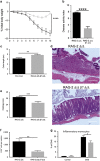β7-Integrin exacerbates experimental DSS-induced colitis in mice by directing inflammatory monocytes into the colon
- PMID: 26349655
- PMCID: PMC4801899
- DOI: 10.1038/mi.2015.82
β7-Integrin exacerbates experimental DSS-induced colitis in mice by directing inflammatory monocytes into the colon
Abstract
Leukocyte recruitment is pivotal for the initiation and perpetuation of inflammatory bowel disease (IBD) and controlled by the specificity and interactions of chemokines and adhesion molecules. Interactions of the adhesion molecules α4β7-integrin and mucosal addressin cell-adhesion molecule-1 (MAdCAM-1) promote the accumulation of pathogenic T-cell populations in the inflamed intestine. We aimed to elucidate the significance of β7-integrin expression on innate immune cells for the pathogenesis of IBD. We demonstrate that β7-integrin deficiency protects recombination-activating gene-2 (RAG-2)-deficient mice from dextran sodium sulfate (DSS)-induced colitis and coincides with decreased numbers of colonic effector monocytes. We also show that β7-integrin is expressed on most CD11b(+)CD64(low)Ly6C(+) bone marrow progenitors and contributes to colonic recruitment of these proinflammatory monocytes. Importantly, adoptive transfer of CD115(+) wild-type (WT) monocytes partially restored the susceptibility of RAG-2/β7-integrin double-deficient mice to DSS-induced colitis, thereby demonstrating the functional importance of β7-integrin-expressing monocytes for the development of DSS colitis. We also reveal that genetic ablation of MAdCAM-1 ameliorates experimental colitis in RAG-2-deficient mice as well. In summary, we demonstrate a previously unknown role of α4β7-integrin-MAdCAM-1 interactions as drivers of colitis by directing inflammatory monocytes into the colon.
Figures







Similar articles
-
Regulatory T-cell depletion in the gut caused by integrin β7 deficiency exacerbates DSS colitis by evoking aberrant innate immunity.Mucosal Immunol. 2016 Mar;9(2):391-400. doi: 10.1038/mi.2015.68. Epub 2015 Jul 29. Mucosal Immunol. 2016. PMID: 26220167
-
MAdCAM-1/α4β7 Integrin-Mediated Lymphocyte/Endothelium Interactions Exacerbate Acute Immune-Mediated Hepatitis in Mice.Cell Mol Gastroenterol Hepatol. 2021;11(4):1227-1250.e1. doi: 10.1016/j.jcmgh.2020.12.003. Epub 2020 Dec 13. Cell Mol Gastroenterol Hepatol. 2021. PMID: 33316453 Free PMC article.
-
A mutation that blocks integrin α4β7 activation prevents adaptive immune-mediated colitis without increasing susceptibility to innate colitis.BMC Biol. 2020 Jun 10;18(1):64. doi: 10.1186/s12915-020-00784-6. BMC Biol. 2020. PMID: 32522281 Free PMC article.
-
Role of beta7 integrins in intestinal lymphocyte homing and retention.Curr Mol Med. 2009 Sep;9(7):836-50. doi: 10.2174/156652409789105525. Curr Mol Med. 2009. PMID: 19860663 Free PMC article. Review.
-
Leukocyte Trafficking to the Small Intestine and Colon.Gastroenterology. 2016 Feb;150(2):340-54. doi: 10.1053/j.gastro.2015.10.046. Epub 2015 Nov 6. Gastroenterology. 2016. PMID: 26551552 Free PMC article. Review.
Cited by
-
β7 Integrin Inhibition Can Increase Intestinal Inflammation by Impairing Homing of CD25hiFoxP3+ Regulatory T Cells.Cell Mol Gastroenterol Hepatol. 2020;9(3):369-385. doi: 10.1016/j.jcmgh.2019.10.012. Epub 2019 Nov 9. Cell Mol Gastroenterol Hepatol. 2020. PMID: 31707128 Free PMC article.
-
Origin, Differentiation, and Function of Intestinal Macrophages.Front Immunol. 2018 Nov 27;9:2733. doi: 10.3389/fimmu.2018.02733. eCollection 2018. Front Immunol. 2018. PMID: 30538701 Free PMC article. Review.
-
Retinoic Acid Signaling Is Compromised in DSS-Induced Dysbiosis.Nutrients. 2022 Jul 6;14(14):2788. doi: 10.3390/nu14142788. Nutrients. 2022. PMID: 35889745 Free PMC article.
-
Vedolizumab: Potential Mechanisms of Action for Reducing Pathological Inflammation in Inflammatory Bowel Diseases.Front Cell Dev Biol. 2021 Feb 3;9:612830. doi: 10.3389/fcell.2021.612830. eCollection 2021. Front Cell Dev Biol. 2021. PMID: 33614645 Free PMC article. Review.
-
Fasting-Mimicking Diet Modulates Microbiota and Promotes Intestinal Regeneration to Reduce Inflammatory Bowel Disease Pathology.Cell Rep. 2019 Mar 5;26(10):2704-2719.e6. doi: 10.1016/j.celrep.2019.02.019. Cell Rep. 2019. PMID: 30840892 Free PMC article.
References
-
- Springer, T.A. Traffic signals for lymphocyte recirculation and leukocyte emigration: The multistep paradigm. Cell 76, 301–314 (1994). - PubMed
-
- Powrie, F. T cells in inflammatory bowel disease: protective and pathogenic roles. Immunity 3, 171–174 (1995). - PubMed
-
- Wagner, N. et al. Critical role for beta7 integrins in formation of the gut-associated lymphoid tissue. Nature 382, 366–370 (1996). - PubMed
-
- Berlin, C. et al. Alpha 4 beta 7 integrin mediates lymphocyte binding to the mucosal vascular addressin MAdCAM-1. Cell 74, 185–195 (1993). - PubMed
-
- Briskin, M.J., McEvoy, L.M. & Butcher, E.C. MAdCAM-1 has homology to immunoglobulin and mucin-like adhesion receptors and to IgA1. Nature 363, 461–464 (1993). - PubMed
Publication types
MeSH terms
Substances
LinkOut - more resources
Full Text Sources
Other Literature Sources
Molecular Biology Databases
Research Materials

